Ross Gittins was formerly one of the few bright spots in the mainstream media’s coverage of immigration.
If you search “immigration” on Ross Gittins’ website, you’ll come across a slew of articles advocating against a ‘Big Australia’ on economic, environmental, and liveability grounds.
In September 2023, I accused Ross Gittins of selling out to the ‘Big Australia’ lobby after publishing a series of articles supporting the Albanese government’s record immigration program.
Ross Gittins responded in October 2023 arguing that cutting immigration is one of the best ways to boost the nation’s productivity growth:
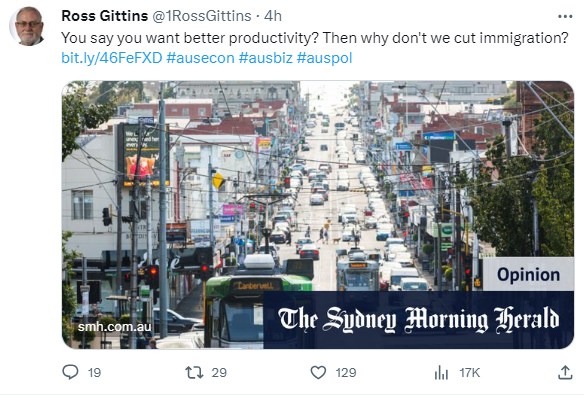
Below are highlights of Gittins’ brilliant October 2023 article:
“Whatever economic benefits immigration may or may not bring, it comes with inescapable economic costs”.
“Which are? That every extra person dilutes our existing per-person investment in business equipment and structures, housing stock and public infrastructure: schools, hospitals, police stations, roads and bridges, and much else”.
“In other words, every extra person requires us to spend many resources on preventing this population growth from diminishing our economic and social capital per head, and thereby making us worse off”.
“Economists call this “capital widening”, as opposed to “capital deepening”, which means providing the population with more capital equipment and infrastructure per person”.
“Trouble is, there’s a limit to how much the nation can save – or borrow from overseas – to finance our investment in housing, business equipment and structures, and public infrastructure. So resources we have to devote to capital widening, thanks to population growth, are resources we can’t devote to the capital deepening that would increase our standard of living”.
“Using immigration to raise our living standards is like trying to go up a down escalator. You have to run just to stop yourself going backwards. This is smart?”…
“Is it mere coincidence that productivity improvement has been weak during the period in which immigration-driven population growth has been so strong? I doubt it”..
“Another thing to remember is that the easier you make it for businesses to get the skilled workers they need by bringing them in from abroad, the more you tempt them not to go to the expense and inconvenience of bothering with apprentices and trainees”.
“Have you joined the dots? If giving business what it wants – high immigration to grow the market and provide ready access to skilled and unskilled workers – hasn’t induced business to increase the productivity of its labour, why don’t we try the opposite?”…
“The strange thing is that the virtue of rapid population growth goes almost wholly unquestioned by the nation’s economists”.
“Population growth is an article of faith for almost every economist. For a profession that prides itself on being so “rational”, it’s surprising how little thinking economists do about the pros and cons of immigration”…
“If there is evidence higher population growth leads to higher income per person, I’ve yet to see it”.
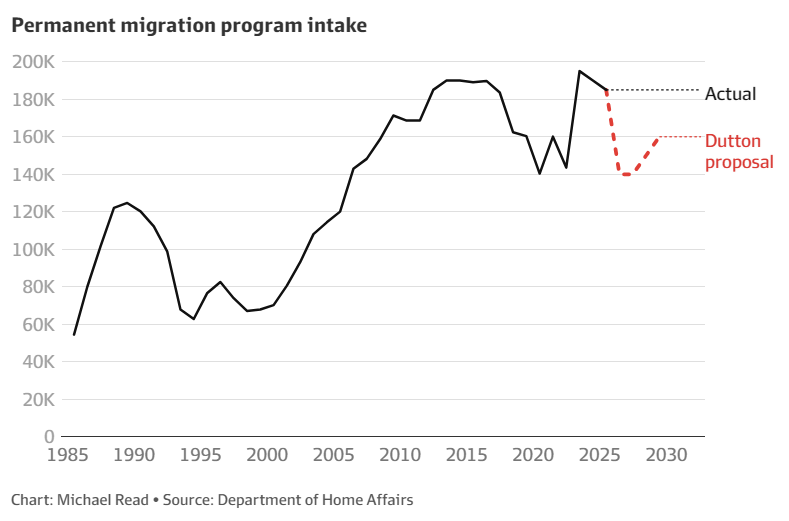
Now that the Coalition has promised a small cut to the permanent migrant intake, alongside lower temporary migration, Gittins has published an article claiming that “politicians don’t control migrant numbers, and usually don’t want to”:
“The way we run immigration, it [the government] has little control over the tap”…
“The telltale sign that Dutton is fudging is his plan to make more homes available by cutting the government’s permanent migration program from 185,000 a year to 140,000”.
“The government does control the size of this program, and often moves it up or down a bit, but the size of the program makes little difference to what matters most for the economy: annual net overseas migration”.
“The trick is that about 65 per cent of the permanent visas go to people who are already here on temporary visas. Changing their visa status makes no difference to net overseas migration”.
“At times like this, the pollies would like you to think they have the power to move immigration up or down according to the economy’s needs at the time”.
“But they don’t. For the most part, the level of net migration is, as economists would say, “demand determined”. And, as the demographers will tell you, net migration tends to go up and down with the state of our economy”.
“When the economy’s booming, migrants are keen to come to Australia, and our employers are keen to have them, particularly if they have skills. What’s more, locals and former immigrants are more likely to want to stay here than go overseas”.
“It’s a different story when our economy’s weak. Employers are less keen to bring in people and migrants are less keen to come”.
The notion that the federal government doesn’t control migration numbers is asinine.
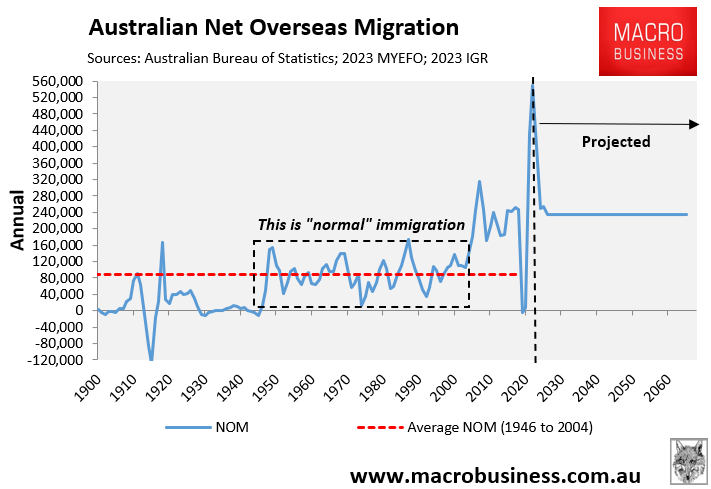
If this claim were true, we wouldn’t see the business lobby and pro-migration groups always lobbying for more immigration. Nor would we have seen such a vicious pushback from these same groups against Dutton’s proposed permanent migrant cut or the bipartisan promise to cap international student numbers.
Why would these groups bother to lobby the federal government if it doesn’t control migration numbers anyway? Gittins’ argument doesn’t make sense.
Gittins’ claim that migration flows are determined by the state of the economy is also wrong. Australia’s economy has been in a funk for more than a decade, yet migration numbers have remained strong throughout.
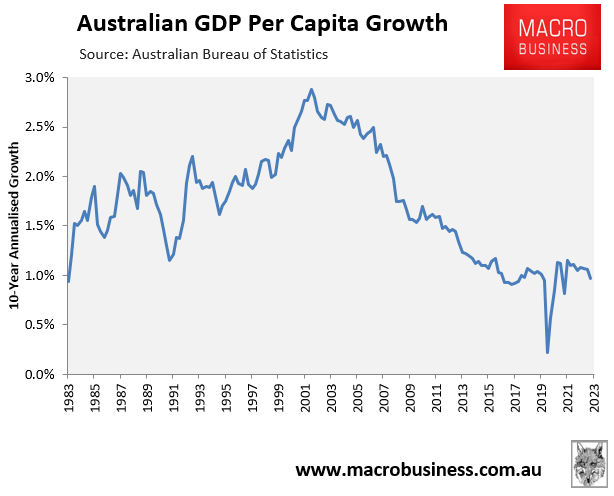
Gittins’ claim that cuts to the permanent migrant intake make little difference to net overseas migration is equally asinine.
Australia’s population has exploded by 8.2 million people this century. Over that time, Australia has issued 4 million permanent migration visas (including the humanitarian intake). This dwarfs the growth of temporary visas, whose stock currently stands at 2.4 million (excluding visitors).
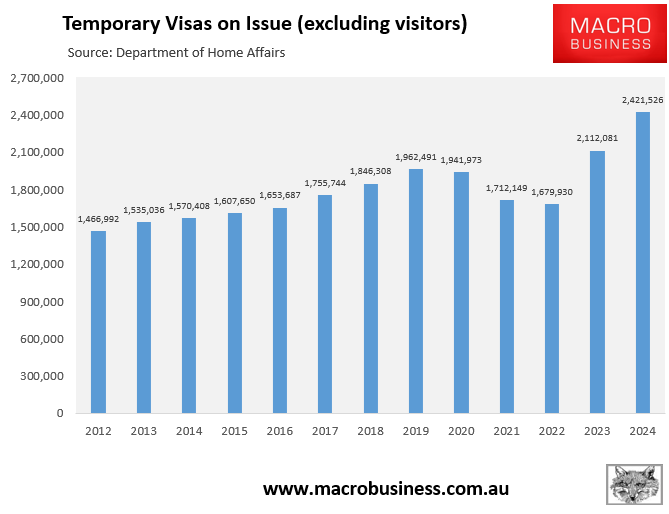
Temporary residents are by definition temporary. So, unless they can convert to permanent residency, they eventually will have to leave, even if it takes several years.
Therefore, it is the permanent migrant intake that is the key driver of Australia’s population growth since this is what grows the population base over time both directly, as well as indirectly, as these new Australian permanent residents have children (counted as ‘natural increase’).
To really hammer the point home, let’s conduct a quick thought experiment. If Australia theoretically slashed the permanent migrant intake to zero, there would be three broad impacts on population growth:
- It would reduce the flow of temporary migrants, since many migrants enter Australia on temporary visas first hoping to transition to one of the many permanent non-humanitarian visas handed out each year (capped at 185,000 for next financial year). Eliminating permanent visas eliminates the probability of gaining permanent residency and, therefore, reduces the incentive to come to Australia in the first place.
- The temporary migrants that cannot transition to permanent residency because the permanent intake has closed would have to leave Australia, thus significantly lowering net overseas migration (NOM) and population growth.
- Fewer permanent residencies means fewer migrants having children, thereby reducing natural increase as well.
So, if the permanent migrant intake was hypothetically reduced to zero, then temporary migrants would eventually have to leave, inflows would roughly match outflows over the longer-term, and NOM and by extension Australia’s population would barely increase:
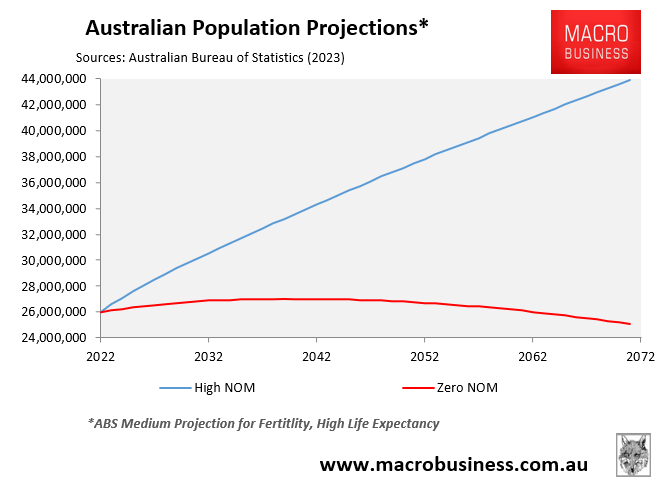
To be sure, there are valid reasons to be sceptical about the Coalition’s migration policy. It’s plan to lift permissible student work hours to 30 hours a week (up from 24 hours currently and 20 hours pre-pandemic) is asinine and would turn student visas into defacto low-skilled work visas.
The Coalition’s planned migration cuts also do not go far enough and would merely deliver a Big Australia rather than Labor’s Huge Australia.
However, it is ridiculous for Ross Gittins to claim that “politicians don’t control migrant numbers” when they literally set immigration policy.

